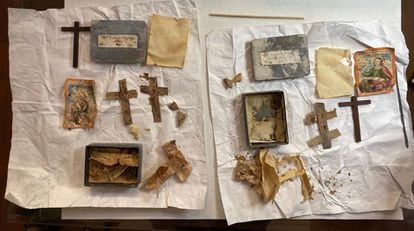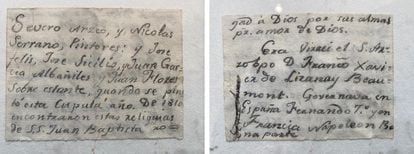One day in late December, after 10 a.m., a clay tile from the main dome. Metropolitan Cathedral Arrived from Mexico and revealed the first find: a lead box attached to the palm of the restorer and bearing an inscription in Latin. Inside, there was a painting representing a passage The Bible And it was drawn in colors on parchment. The workers continued to remove the tiles for eight hours, resulting in 22 dull metal boxes with the same white spots as the first. The discovery occurred during the restoration of the cathedral Suffered “moderate” damage in the 2017 earthquake And constant security work is required. When finished, the workers knew they had valuables on their hands.
Arturo Balandros, Director of Cultural Heritage Sites and Monuments at Mexico’s Ministry of Culture, spoke at the conference on Friday. morning of Govt to report findings. “It’s very exciting,” Palandros celebrated. The official assured that this type of discovery “usually” occurs when relics “of this antiquity and of this history” intervene. Balandros says that since the 2017 earthquake, 1,579 temples have been restored. “In the hypothesis of cathedral researchers and theologians, these boxes contain images of patron saints who spread a shroud over the cathedral complex of our city,” he said.

The boxes appeared in the small rectangular and shallow niches that can be seen in the lanterns of the cathedral, i.e., the ducted space that completes the central dome of the religious building and allows the entry of light and air. Maricarmen Castro, National Anthropology and History Restoration Coordinator, tells EL PAÍS that for 10 days they worked in “forced marches” to examine the objects. “It’s a unique opportunity,” says the restorer. Although experts cannot determine with certainty who placed them and when, they estimate that they may have been in the 17th or 18th century to protect the building. That’s why the dean ordered a crucifix and a religious image to “continue with safety” in place of each, when the boxes were removed for their inspection.
Some of the 23 boxes have Latin inscriptions referring to saints or divine beings. For example, in one of them is written a prayer asking Jesus of Nazareth for protection and mercy: Jesus Nazarenes Rex Judeorum. Titus triumphalis protects us. Sancte deu, Sante fortis, Sante immortalis miserere nobis. Others, on the other hand, don’t have any kind of hint that lets them know what’s inside. Opening them, experts found fragments that “probably” formed paintings, wooden and palm crosses, or clay and wax medallions. Some were in a good state of preservation, but others can be seen in the published images Ministry of Culture, damaged by moisture or incomplete or broken. A box was ransacked and there was nothing inside.
Balandros pointed out that these findings “speak to the final period of the construction of the cathedral”. The Metropolitan Cathedral of Mexico, located on one side The capital is the zócalo, built over 240 years between 1573 and 1813. It was actually the second cathedral built. The architect who started it was Claudio de Arcinica, who recreated the Salamanca Cathedral project in Spain. When it was finished, the architect responsible for the works was already Manuel Tolza. It completed the façade, towers and dome. One of the painters who intervened in the cathedral at the time “and may have been part of the team of the architect Tolza” found one of the boxes already dedicated to Saint John the Baptist.
The group that discovered the boxes in December was able to find them because one of them contained a paper dated 1810 with the following inscription: “When Severo Arceo and Nicolas Serrano, painters, and Jose Felix, Jose Cecilio and Juan Garcia, bricklayers, and Juan Flores, on a shelf, painted this dome. , in 1810, they found the relics of His Holiness Juan Bautista. And I pray to God to rest their souls in peace. Archbishop Don Francisco Xavier de Lizana y Beaumont Viceroy, Fernando VII ruled in Spain and Napoleon Bonaparte in France. Restorers believe the box was “discovered and opened that year.”

After discovery and analysis by experts from the National Institute of Anthropology and History, officials expect the boxes to be returned to “their original state” in the central dome light by the end of January. They will be returned with protective packaging that favors their safety. When they are reintegrated, work on the cathedral, which began in 2019, will be completed. Since then, attention has been paid to piles to maintain the stability of a building erected on a constantly sinking ground; Vegetation grown on the joints of the stones has been removed; The electrical system and lightning wire system have been reconstructed.
Subscribe here to do newsletter Get all the important information about current affairs in this country from EL PAÍS México


/cloudfront-us-east-1.images.arcpublishing.com/eluniverso/V73VDLEC6JDS5EXKLSG7SLUX4Y.png)


